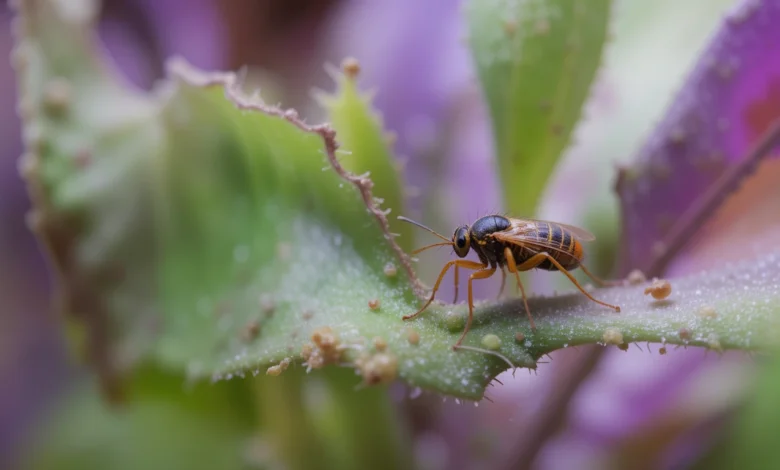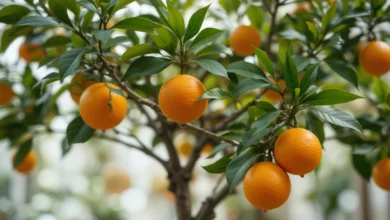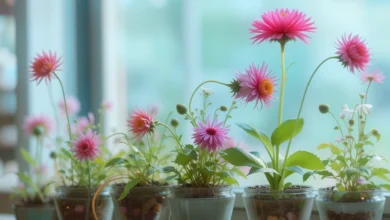How to Get Rid of Gnats in Houseplants – Easy and Effective Tips

If you’ve ever noticed tiny flying insects around your houseplants, you’re probably dealing with gnats. These little pests are more than just annoying—they can harm your plants if left unchecked. Fungus gnats, the most common type of gnat, love moist soil and can damage the roots of your plants. But don’t worry! In this article, we’ll show you how to get rid of gnats in your houseplants with easy and effective methods. Plus, we’ll provide tips to keep your plants safe and healthy, so you can enjoy a gnat-free home.
What Are Fungus Gnats?
Fungus gnats are tiny flying insects that are commonly found in the soil of houseplants. They resemble small mosquitoes and are usually black or dark gray. They’re most active in the evening and like to hover around plants, especially when the soil is damp. While adult gnats are annoying, it’s their larvae that cause the real damage.
The larvae live in the soil and feed on the roots of your plants. This can weaken the plant, cause yellowing leaves, and even lead to plant death in severe cases. The good news is that with a few simple steps, you can get rid of gnats in houseplants and protect your greenery from further harm.
Why Do You Have Gnats in Your Houseplants?
Gnats are attracted to damp environments, and houseplants with overly moist soil provide the perfect breeding ground for these pests. If you’ve been watering your plants too much, the soil may stay moist for longer periods, allowing gnats to lay their eggs in it. Once the eggs hatch, the larvae begin to feed on the plant’s roots, creating a cycle of infestation.
Signs of a Gnat Infestation
Before you start taking action, it’s important to confirm that you have a gnat problem. Here are some signs to look for:
- Tiny Flying Insects: Adult gnats can often be seen flying around your plants, especially near the soil.
- Yellowing Leaves: If the plant’s roots are being damaged, the leaves may turn yellow.
- Moist Soil: Gnats thrive in damp soil, so overwatering your plants can make your home a perfect environment for them.
- Visible Larvae: If you look closely at the soil, you may see tiny, translucent larvae wiggling around.
If you notice any of these signs, it’s time to act.
How to Get Rid of Gnats in Houseplants
Here are some easy and effective methods to get rid of gnats in your houseplants:
1. Let the Soil Dry Out
Fungus gnats love moist soil, so one of the most effective ways to deal with them is to let the soil dry out. By allowing the top 1-2 inches of soil to dry between waterings, you’re reducing the environment where the gnats can thrive. The larvae in the soil need moisture to survive, so drying out the soil will help disrupt their life cycle.
Tip: Be careful not to let your plants dry out completely. Make sure the bottom of the pot still has some moisture, as plants still need water to survive.
2. Use Sticky Traps
Sticky traps are a great way to capture adult gnats and monitor the severity of your infestation. These traps are typically yellow because gnats are attracted to the color. You can place a few sticky traps near the base of your plants to catch flying gnats. While this won’t eliminate the problem completely, it can help reduce the number of adults and prevent them from laying more eggs.
Tip: You can purchase pre-made sticky traps or create your own using yellow paper coated with petroleum jelly.
3. Cover the Soil with Sand or Gravel
Another simple way to get rid of gnats is to cover the top layer of soil with a thin layer of sand or fine gravel. The gnats typically lay their eggs in the moist top layer of the soil, so covering it with something dry will prevent them from getting to the damp soil beneath. This will also improve drainage and prevent overwatering.
Tip: Use a 1-2 inch layer of sand or fine gravel to cover the soil. This will also help reduce the chances of new gnats returning.
4. Apply Natural Remedies
If you’re looking for a natural solution to get rid of gnats, there are several household items you can use to treat the problem. Here are a few options:
- Apple Cider Vinegar Trap: Fill a small dish with apple cider vinegar and add a few drops of dish soap. The vinegar will attract the gnats, and the soap will trap them. Place the dish near the plants to catch the gnats.
- Cinnamon: Sprinkle a thin layer of cinnamon on the soil. Cinnamon has antifungal properties and can help kill the gnat larvae while also preventing mold and fungi from growing in the soil.
- Neem Oil: Neem oil is a natural insecticide that can be used to kill gnats and other pests. Mix a small amount of neem oil with water and spray it onto the soil and leaves of your plants.
Tip: Always test natural remedies on a small portion of your plant to ensure they don’t harm it.
Raad More: How to Move Indoor Plants Outside for Spring & Summer
5. Repot the Plant
If your plant has a severe gnat infestation, repotting it may be necessary. Carefully remove the plant from its pot and gently shake off the soil. Be sure to discard the old soil to eliminate any gnat larvae. Then, repot the plant in fresh, sterile potting mix. This method will eliminate the gnats and give your plant a fresh start.
Tip: When repotting, make sure the new pot has drainage holes to prevent future gnat infestations.
6. Use Insecticidal Soap
If the infestation persists and other methods don’t seem to be working, you can use insecticidal soap. Insecticidal soap is a natural, non-toxic product that can kill gnats and other pests. Simply follow the instructions on the bottle and spray the soap on the leaves and soil of the affected plant.
Tip: Insecticidal soap is safe for most houseplants, but always check the label to make sure it’s suitable for your specific plant.
7. Prevent Future Infestations
Once you’ve gotten rid of the gnats, it’s important to prevent them from coming back. Here are some tips to keep your plants gnat-free:
- Water Properly: Avoid overwatering your plants, as this can create a damp environment for gnats. Let the soil dry out between waterings.
- Good Drainage: Ensure your pots have proper drainage to prevent water from accumulating in the soil.
- Inspect New Plants: When bringing new plants into your home, inspect them carefully for signs of pests before placing them near your other plants.
- Keep Your Home Clean: Regularly clean the area around your plants to reduce the chances of pests settling in.
Additional Tips for Healthy Houseplants
While getting rid of gnats is important, it’s also essential to take care of your plants to ensure they remain healthy and strong:
- Provide Adequate Light: Make sure your plants are getting enough light. Most indoor plants need bright, indirect light to grow well.
- Fertilize Regularly: Use a balanced fertilizer to provide your plants with the nutrients they need to grow.
- Check for Pests: Regularly inspect your plants for signs of pests or disease. Early detection can help prevent infestations from spreading.
Conclusion
Gnats can be a nuisance, but with the right methods, you can get rid of them and keep your houseplants healthy. By following the tips in this article, you can eliminate gnats, prevent future infestations, and ensure your plants thrive in a healthy environment. Remember to let the soil dry out between waterings, use sticky traps, cover the soil with sand, and apply natural remedies to get rid of gnats. With a little effort, your plants will be gnat-free and happy!




